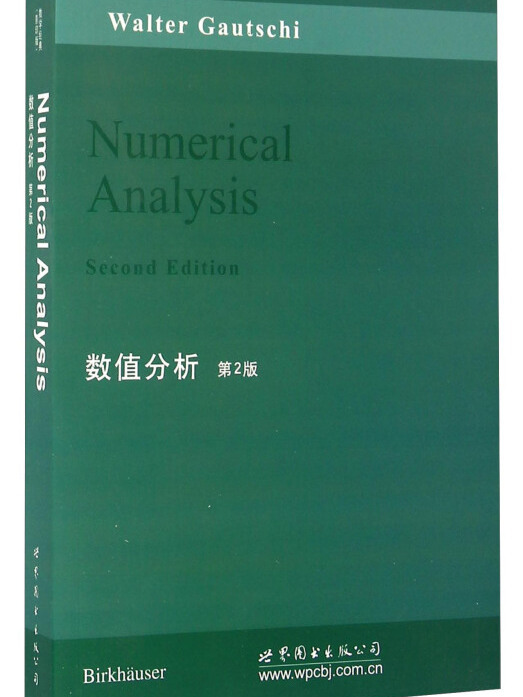內容簡介
《數值分析(第2版 英文版)》為研究生的數值分析教程,包括基礎入門課程和隨後的專業課。後者主要針對數值線性代數、微分方程的數值解,另外增添一些與複變函數論、多維量分析(尤其在最佳化方面)、功能分析及其方程相關的課題。作者感覺當前的一些學科分支,尤其是那些處理線性代數和偏微分方程的學科,已經成為了當前研究的主流。
縱觀上下文,書的前四章可以作為基礎入門課程,剩下的三章可作為高年級學生的教材。
圖書目錄
Prologue
P1 Overview
P2 Numerical Analysis Software
P3 Textbooks and Monographs
P3.1 Selected Textbooks on Numerical Analysis
P3.2 Monographs and Books on Specialized Topics
P4 Journals
1 Machine Arithmetic and Related Matters
1.1 Real Numbers, Machine Numbers, and Rounding
1.1.1 Real Numbers
1.1.2 Machine Numbers
1.1.3 Rounding
1.2 Machine Arithmetic
1.2.1 A Model of Machine Arithmetic
1.2.2 Error Propagation in Arithmetic Operations: Cancellation Error
1.3 The Condition of a Problem
1.3.1 Condition Numbers
1.3.2 Examples
1.4 The Condition of an Algorithm
1.5 Computer Solution of a Problem; Overall Error
1.6 Notes to Chapter 1
Exercises and Machine Assignments to Chapter 1
Exercises
Machine Assignments
Selected Solutions to Exercises
Selected Solutions to Machine Assignments
2 Approximation and Interpolation
2.1 Least Squares Approximation
2.1.1 Inner Products
2.1.2 The Normal Equations
2.1.3 Least Squares Error; Convergence
2.1.4 Examples of Orthogonal Systems
2.2 Polynomial Interpolation
2.2.1 Lagrange Interpolation Formula: Interpolation Operator.
2.2.2 Interpolation Error
2.2.3 Convergence..
2.2.4 Chebyshev Polynomials and Nodes
2.2.5 Barycentric Formula
2.2.6 Newton's Formula
2.2.7 Hermite Interpolation
2.2.8 Inverse Interpolation
2.3 Approximation and Interpolation by Spline Functions
2.3.1 Interpolation by Piecewise Linear Functions
2.3.2 A Basis for St(A)
2.3.3 Least Squares Approximation
2.3.4 Interpolation by Cubic Splines
2.3.5 Minimality Properties of Cubic Spline Interpolants
2.4 Notes to Chapter 2
Exercises and Machine Assignments to Chapter 2
Exercises
Machine Assignments
Selected Solutions to Exercises
Selected Solutions to Machine Assignments
3 Numerical Differentiation and Integration
3.1 Numerical Differentiation
3.1.1 A General Differentiation Formula for Unequally Spaced Points
3.1.2 Examples
3.1.3 Numerical Differentiation with Perturbed Data
3.2 Numerical Integration
3.2.1 The Composite Trapezoidal and Simpson's Rules
3.2.2 (Weighted) Newton-Cotes and Gauss Formulae
3.2.3 Properties of Gaussian Quadrature Rules
3.2.4 Some Applications of the Gauss Quadrature Rule
3.2.5 Approximation of Linear Functionals: Method f Interpolation vs. Method of Undetermined Coefficients
3.2.6 Peano Representation of Linear Functionals
3.2.7 Extrapolation Methods
3.3 Notes to Chapter 3
Exercises and Machine Assignments to Chapter 3
Exercises
Machine Assignments
Selected Solutions to Exercises
Selected Solutions to Machine Assignments
4 Nonlinear Equations
4.1 Examples
4.1.1 A Transcendental Equation
4.1.2 A Two-Point Boundary Value Problem
4.1.3 A Nonlinear Integral Equation
4.1.4 s-Orthogonal Polynomials
4.2 Iteration, Convergence, and Efficiency
4.3 The Methods of Bisection and Sturm Sequences
4.3.1 Bisection Method
4.3.2 Method of Sturm Sequences
4.4 Method of False Position
4.5 Secant Method
4.6 Newton's Method
4.7 Fixed Point Iteration
4.8 Algebraic Equations
4.8.1 Newton's Method Applied to an Algebraic Equation
4.8.2 An Accelerated Newton Method for Equations with Real Roots
4.9 Systems of Nonlinear Equations
4.9.1 Contraction Mapping Principle
4.9.2 Newton's Method for Systems of Equations
4.10 Notes to Chapter 4
Exercises and Machine Assignments to Chapter 4
Exercises
Machine Assignments
Selected Solutions to Exercises
Selected Solutions to Machine Assignments
5 Initial Value Problems for ODEs: One-Step Methods
5.1 Examples
5.2 Types of Differential Equations
5.3 Existence and Uniqueness
5.4 Numerical Methods
5.5 Local Description of One-Step Methods
5.6 Examples of One-Step Methods
5.6.1 Euler's Method
5.6.2 Method of Taylor Expansion
5.6.3 Improved Euler Methods
5.6.4 Second-Order Two-Stage Methods
5.6.5 Runge-Kutta Methods
5.7 Global Description of One-Step Methods
5.7.1 Stability
5.7.2 Convergence
5.7.3 Asymptotics of Global Error
5.8 Error Monitoring and Step Control
5,8.1 Estimation of Global Error
5,8.2 Truncation Error Estimates
5,8.3 Step Control
5.9 Stiff Problems
5,9.1 A-Stability
5.9.2 Pad6 Approximation
5.9.3 Examples of A-Stable One-Step Methods
5.9.4 Regions of Absolute Stability
5.10 Notes to Chapter 5
Exercises and Machine Assignments to Chapter 5
Exercises
Machine Assignments
Selected Solutions to Exercises
Selected Solutions to Machine Assignments
6 Initial Value Problems for ODEs: Multistep Methods
6.1 Local Description of Multistep Methods
6.1.1 Explicit and Implicit Methods
6.1.2 Local Accuracy
6.1.3 Polynomial Degree vs. Order
6.2 Examples of Multistep Methods
6.2.1 Adams-Bashforth Method
6.2.2 Adams-Moulton Method
6.2.3 Predictor-Corrector Methods
6.3 Global Description of Multistep Methods
6.3.1 Linear Difference Equations
6.3.2 Stability and Root Condition
6.3.3 Convergence
6.3.4 Asymptotics of Global Error
6.3.5 Estimation of Global Error
6.4 Analytic Theory of Order and Stability
6.4.1 Analytic Characterization of Order
6.4.2 Stable Methods of Maximum Order
6.4.3 Applications
6.5 Stiff Problems
6.5.1 A-Stability
6.5.2 A(c0-Stability)
6.6 Notes to Chapter 6
Exercises and Machine Assignments to Chapter 6
Exercises
Machine Assignments
Selected Solutions to Exercises
Selected Solutions to Machine Assignments
7 Two-Point Boundary Value Problems for ODEs
7.1 Existence and Uniqueness
7.1.1 Examples
7.1.2 A Scalar Boundary Value Problem
7.1.3 General Linear and Nonlinear Systems
7.2 Initial Value Techniques
7.2.1 Shooting Method for a Scalar Boundary Value Problem
7.2.2 Linear and Nonlinear Systems
7.2.3 Parallel Shooting
7.3 Finite Difference Methods
7.3.1 Linear Second-Order Equations
7.3.2 Nonlinear Second-Order Equations
7.4 Variational Methods
7.4.1 Variational Formulation
7.4.2 The Extremal Problem
7.4.3 Approximate Solution of the Extremal Problem
7.5 Notes to Chapter 7
Exercises and Machine Assignments to Chapter 7
Exercises
Machine Assignments
Selected Solutions to Exercises
Selected Solutions to Machine Assignments
References
Index

